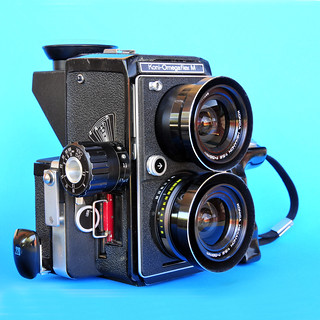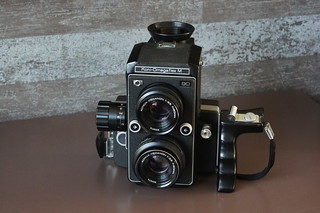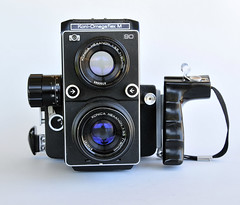Difference between revisions of "Koni-Omegaflex M"
m (moved Koni-Omegaflex to Koni-Omegaflex M over redirect) |
(interlocks, compared to rapid m, back indicator, grip, tripod) |
||
| Line 7: | Line 7: | ||
==Body== | ==Body== | ||
| + | The basic design of the body is similar to the rangefinder Koni-Omega M model, but changes the viewfinder into a ground glass and lens. | ||
| + | |||
Focusing the lens is with the large focusing knob on the right hand side of the main camera body. There is a depth of field scale printed on the body above the focus dial. There are distance scales for 90mm and 135mm lenses on the focusing barrel. Additional distance markings for 58mm and 180mm are on the face of the focusing knob. | Focusing the lens is with the large focusing knob on the right hand side of the main camera body. There is a depth of field scale printed on the body above the focus dial. There are distance scales for 90mm and 135mm lenses on the focusing barrel. Additional distance markings for 58mm and 180mm are on the face of the focusing knob. | ||
| − | The top of the camera has an accessory shoe. The left hand side has a lockable shutter release. It is threaded and can accept a screw-in [[cable release]]. | + | The top of the camera has an accessory shoe. The left hand side has a lockable shutter release. It is threaded and can accept a screw-in [[cable release]]. An accessory grip can attach to the left-hand side of the body. The shutter release button is typically within reach with the grip attached. The grip can also hold the tip of a cable release head. The positioning of the grip can also be rotated. There are two tripod sockets in 1/4" and 3/8" , one on the base and another on the left hand side which is also used for the hand grip. |
| + | |||
| + | There are numerous interlocks on the camera involving the darkslide. The shutter release cannot be tripped and the lens cannot be removed with the darkslide inserted. | ||
==Film== | ==Film== | ||
| − | The camera shoots 6×7 cm negatives on [[120 film]] or 220 film. There are 10 exposures with 120 film, while 220 film yields 20 exposures. Like the rest of the Koni-Omega series type cameras, the film is loaded onto the same two part film magazines, and uses a pull push knob for film advance built-into the magazine. The back has the film counter and a reminder slot for film emulsion box tabs. | + | The camera shoots 6×7 cm negatives on [[120 film]] or 220 film. There are 10 exposures with 120 film, while 220 film yields 20 exposures. Like the rest of the Koni-Omega series type cameras, the film is loaded onto the same two part film magazines, and uses a pull push knob for film advance and shutter cocking that is built-into the magazine. The back has the film counter and a reminder slot for film emulsion box tabs. There's a film ready indicator on the backs to show that the shutter is cocked and film is advanced to an unexposed frame. |
==Lens== | ==Lens== | ||
| Line 47: | Line 51: | ||
* Eye level with 3x magnifier | * Eye level with 3x magnifier | ||
* Reflex with 2.8x magnifier | * Reflex with 2.8x magnifier | ||
| − | '''Film | + | '''Film''' |
| − | * 120 film | + | * 120 film holder |
| − | * 220 film | + | * 220 film holder |
== Bibliography == | == Bibliography == | ||
* {{Lewis}} P. 125. | * {{Lewis}} P. 125. | ||
| Line 58: | Line 62: | ||
In English: | In English: | ||
* [http://www.peterlanczak.de/koniflex.htm Koni-Omegaflex M] in Peter Lanczak's [http://www.peterlanczak.de/koni.htm site about the Koni-Omega] (also in German and French) | * [http://www.peterlanczak.de/koniflex.htm Koni-Omegaflex M] in Peter Lanczak's [http://www.peterlanczak.de/koni.htm site about the Koni-Omega] (also in German and French) | ||
| − | * [http://www.butkus.org/chinon/koni-omega/koni-omegaflex/koni-omegaflex.htm Koni-Omegaflex M] instruction manual at http://www.butkus.org | + | * [http://www.butkus.org/chinon/koni-omega/koni-omegaflex/koni-omegaflex.htm Koni-Omegaflex M] instruction manual at [http://www.butkus.org Mike Butkus Orphan Cameras] |
In French: | In French: | ||
* [http://dirapon.be/koniomega.html Koni Omegaflex M and comparison with Rapid Omega 100] on Dirapon website | * [http://dirapon.be/koniomega.html Koni Omegaflex M and comparison with Rapid Omega 100] on Dirapon website | ||
Revision as of 05:47, 4 July 2014
The Koni-Omegaflex M is a medium format based TLR press camera system with exchangeable lens board, finders and film magazines. It was made in Japan by Konica for Simmons Omega Inc. which was a subsidiary of Berkey.
See here for the serial numbers which allow to date the production of the unit.
Body
The basic design of the body is similar to the rangefinder Koni-Omega M model, but changes the viewfinder into a ground glass and lens.
Focusing the lens is with the large focusing knob on the right hand side of the main camera body. There is a depth of field scale printed on the body above the focus dial. There are distance scales for 90mm and 135mm lenses on the focusing barrel. Additional distance markings for 58mm and 180mm are on the face of the focusing knob.
The top of the camera has an accessory shoe. The left hand side has a lockable shutter release. It is threaded and can accept a screw-in cable release. An accessory grip can attach to the left-hand side of the body. The shutter release button is typically within reach with the grip attached. The grip can also hold the tip of a cable release head. The positioning of the grip can also be rotated. There are two tripod sockets in 1/4" and 3/8" , one on the base and another on the left hand side which is also used for the hand grip.
There are numerous interlocks on the camera involving the darkslide. The shutter release cannot be tripped and the lens cannot be removed with the darkslide inserted.
Film
The camera shoots 6×7 cm negatives on 120 film or 220 film. There are 10 exposures with 120 film, while 220 film yields 20 exposures. Like the rest of the Koni-Omega series type cameras, the film is loaded onto the same two part film magazines, and uses a pull push knob for film advance and shutter cocking that is built-into the magazine. The back has the film counter and a reminder slot for film emulsion box tabs. There's a film ready indicator on the backs to show that the shutter is cocked and film is advanced to an unexposed frame.
Lens
Each lens board includes a lens pair and a leaf shutter made by Seiko. Aperture and shutter speeds are adjusted on the lens. The shutter speed range from B, 1 to 1/500th of a second. There are f/5.6 58mm, f/3.5 90mm, f/3.5 135mm, and f/4.5 180mm lens boards. Each lens has a minimum aperture of f/22 and has a built-in lens hood or the taking lens. Mounting each lens changes the parallax view within the finder. The lenses can be changed mid-roll with the use of a dark slide. Flash sync can use both bulbs and electronic flash with a MX selector. It uses a standard PC sync connector on each lens board.
Finder
The finder is primarily designed for eye level viewing instead of waist level common with most TLR. There is a flip open hood on the back of the camera that reveals a ground glass. Viewing in this manner is similar to a large format camera with the image upside down. This can be changed to a prism or magnifier. With the prism, images are right side up and can be used for waist level viewing.

|
| Koni-Omegaflex M with Hexanon 58mm f/5.8 lens board and reflex angle viewfinder, image by Dirk HR Spennemann (Image rights) |
System

|
| image by René Maly (Image rights) |
Lens
- 58mm Hexanon f/5.6 (wide) 8 element, 4 group. series 7
- 90mm Hexanon f/3.5 (normal) 4 element, 3 group. series 6
- 135mm Hexanon f/3.5 6 element, 5 group. series 8
- 180mm Hexanon f/4.5 5 element, 4 group. series 8
Finder
- Folding hood
- Eye level with 3x magnifier
- Reflex with 2.8x magnifier
Film
- 120 film holder
- 220 film holder
Bibliography
- Lewis, Gordon, ed. The History of the Japanese Camera. Rochester, N.Y.: George Eastman House, International Museum of Photography & Film, 1991. ISBN 0-935398-17-1 (paper), 0-935398-16-3 (hard). P. 125.
- McKeown, James M. and Joan C. McKeown's Price Guide to Antique and Classic Cameras, 12th Edition, 2005-2006. USA, Centennial Photo Service, 2004. ISBN 0-931838-40-1 (hardcover). ISBN 0-931838-41-X (softcover). P. 539.
- Sugiyama, Kōichi (杉山浩一); Naoi, Hiroaki (直井浩明); Bullock, John R. The Collector's Guide to Japanese Cameras. 国産カメラ図鑑 (Kokusan kamera zukan). Tokyo: Asahi Sonorama, 1985. ISBN 4-257-03187-5. Item 2139.
Links
In English:
- Koni-Omegaflex M in Peter Lanczak's site about the Koni-Omega (also in German and French)
- Koni-Omegaflex M instruction manual at Mike Butkus Orphan Cameras
In French:
- Koni Omegaflex M and comparison with Rapid Omega 100 on Dirapon website
